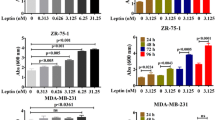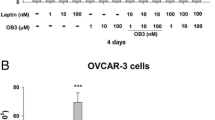Abstract
Leptin induces ovarian cancer cell invasion via overexpression of MMP7, MMP9, and upA. In addition, the key role of ERα in leptin-increased cell growth was indicated. However, the influence of ER on leptin-mediated cell invasion remains still unknown. The present study was designed to evaluate the E2-independent effect of ERα/β on leptin-mediated cell invasion and cell proliferation in ovarian cancer. We utilized SKOV3 cancer (expressing OB-Rb and ERα/β, insensitive to estrogen) and OVCAR3 (expressing OB-Rb) cell lines to show the involvement of ER in leptin-mediated effects in an E2-independent manner. MTT, BrdU, and BD matrigel invasion assays were applied to analyze cell growth, proliferation, and invasion. The siRNA approach was used to confirm the role of ERα/β in leptin effects. Moreover, western blotting and Real-time PCR were employed to detect the OB-Rb, ER, MMP9/7, and upA proteins and mRNAs. Leptin, in the absence of E2, increased ERα expression in SKOV3 cells, which was attenuated using knockdown of OB-Rb gene by siRNA. The effect of leptin on the cell growth was promoted in the presence of PPT, but not in the presence of DNP and E2, which was lost when OB-Rb siRNA was transfected. Furthermore, ERα gene silencing and/or pre-incubation with ER antagonist (ICI 182,780, 10 nM) significantly reduced cell invasion and MMP9 expression stimulated by leptin. In conclusion, our findings demonstrated that ERα, but not ERβ, is involved in leptin-induced ovarian cancer in an E2-independent manner, providing new evidence for cancer progression in obesity-associated ovarian cancer.






Similar content being viewed by others
References
Ng M, Fleming T, Robinson M, Thomson B, Graetz N, Margono C, Mullany EC, Biryukov S, Abbafati C, Abera SF (2014) Global, regional, and national prevalence of overweight and obesity in children and adults during 1980–2013: a systematic analysis for the Global Burden of Disease Study 2013. Lancet 384:766–781
Organization WH (2016) World Health Organization obesity and overweight fact sheet
Picon-Ruiz M, Morata-Tarifa C, Valle-Goffin JJ, Friedman ER, Slingerland JM (2017) Obesity and adverse breast cancer risk and outcome: mechanistic insights and strategies for intervention. CA: Cancer J Clin 67:378–397
Shaw E, Farris M, McNeil J, Friedenreich C (2016) Obesity and endometrial cancer. Obesity and Cancer. Springer, Cham, pp 107–136
Tworoger SS, Huang T (2016) Obesity and ovarian cancer. Obesity and Cancer. Springer, Cham, pp 155–176
Roberts DL, Dive C, Renehan AG (2010) Biological mechanisms linking obesity and cancer risk: new perspectives. Annu Rev Med 61:301–316
Louie SM, Roberts LS, Nomura DK (2013) Mechanisms linking obesity and cancer. Biochim Biophys Acta (BBA)-Mol Cell Biol Lipids 1831:1499–1508
Trayhurn P, Bing C (2006) Appetite and energy balance signals from adipocytes. Philos Trans R Soc Lond B 361:1237–1249
Margetic S, Gazzola C, Pegg G, Hill R (2002) Leptin: a review of its peripheral actions and interactions. Int J Obes 26:1407
VanSaun MN (2013) Molecular pathways: adiponectin and leptin signaling in cancer. Clin Cancer Res. https://doi.org/10.1158/1078-0432.CCR-12-0930
Ray A, Cleary MP (2017) The potential role of leptin in tumor invasion and metastasis. Cytokine Growth Factor Rev. https://doi.org/10.1016/j.cytogfr.2017.11.002
Vargas AN (2014) Natural history of ovarian cancer. Ecancermedicalscience 8:465. https://doi.org/10.3332/ecancer.2014.465
Jemal A, Bray F, Center MM, Ferlay J, Ward E, Forman D (2011) Global cancer statistics. CA: Cancer J Clin 61:69–90
Romero I, Bast RC Jr (2012) Minireview: human ovarian cancer: biology, current management, and paths to personalizing therapy. Endocrinology 153:1593–1602
Lengyel E (2010) Ovarian cancer development and metastasis. Am J Pathol 177:1053–1064
Leitzmann MF, Koebnick C, Danforth KN, Brinton LA, Moore SC, Hollenbeck AR, Schatzkin A, Lacey JV Jr (2009) Body mass index and risk of ovarian cancer. Cancer: Interdiscip Int J Am Cancer Soc 115:812–822
Uddin S, Bu R, Ahmed M, Abubaker J, Al-Dayel F, Bavi P, Al-Kuraya KS (2009) Overexpression of leptin receptor predicts an unfavorable outcome in Middle Eastern ovarian cancer. Mol Cancer 8:74
Ghasemi A, Hashemy SI, Aghaei M, Panjehpour M (2017) RhoA/ROCK pathway mediates leptin-induced uPA expression to promote cell invasion in ovarian cancer cells. Cell Signal 32:104–114
Ghasemi A, Hashemy SI, Aghaei M, Panjehpour M (2018) Leptin induces matrix metalloproteinase 7 expression to promote ovarian cancer cell invasion by activating ERK and JNK pathways. J Cell Biochem 119:2333–2344
Kato S, Abarzua-Catalan L, Trigo C, Delpiano A, Sanhueza C, García K, Ibañez C, Hormazábal K, Diaz D, Brañes J (2015) Leptin stimulates migration and invasion and maintains cancer stem-like properties in ovarian cancer cells: an explanation for poor outcomes in obese women. Oncotarget 6:21100
Cunat S, Hoffmann P, Pujol P (2004) Estrogens and epithelial ovarian cancer. Gynecol Oncol 94:25–32
Matthews J, Gustafsson J-Å (2003) Estrogen signaling: a subtle balance between ERα and ERβ. Mol Interv 3:281
Brandenberger AW, Tee MK, Jaffe RB (1998) Estrogen receptor alpha (ER-α) and beta (ER-β) mRNAs in normal ovary, ovarian serous cystadenocarcinoma and ovarian cancer cell lines: down-regulation of ER-β in neoplastic tissues. J Clin Endocrinol Metab 83:1025–1028
Liao XH, Lu DL, Wang N, Liu LY, Wang Y, Li YQ, Yan TB, Sun XG, Hu P, Zhang TC (2014) Estrogen receptor α mediates proliferation of breast cancer MCF-7 cells via a p21/PCNA/E2F1-dependent pathway. FEBS J 281:927–942
Lazennec G (2006) Estrogen receptor beta, a possible tumor suppressor involved in ovarian carcinogenesis. Cancer Lett 231:151–157
Andersen CL, Sikora MJ, Boisen MM, Ma T, Christie A, Tseng G, Park YS, Luthra S, Chandran U, Haluska P (2017) Active estrogen receptor-alpha signaling in ovarian cancer models and clinical specimens. Clin Cancer Res. https://doi.org/10.1158/1078-0432.CCR-16-1501
Lau K-M, Mok SC, Ho S-M (1999) Expression of human estrogen receptor-α and -β, progesterone receptor, and androgen receptor mRNA in normal and malignant ovarian epithelial cells. Proc Natl Acad Sci 96:5722–5727
Vierikko P, Kauppila A, Vihko R (1983) Cytosol and nuclear estrogen and progestin receptors and 17 beta-hydroxysteroid dehydrogenase activity in non-diseased tissue and in benign and malignant tumors of the human ovary. Int J Cancer 32:413–422
Choi J-H, Lee K-T, Leung PC (2010) Estrogen receptor alpha pathway is involved in leptin-induced ovarian cancer cell growth. Carcinogenesis 32:589–596
Rutherford T, Brown WD, Sapi E, Aschkenazi S, Muñoz A, Mor G (2000) Absence of estrogen receptor-β expression in metastatic ovarian cancer. Obstet Gynecol 96:417–421
Pujol P, Rey J-M, Nirde P, Roger P, Gastaldi M, Laffargue F, Rochefort H, Maudelonde T (1998) Differential expression of estrogen receptor-α and-β messenger RNAs as a potential marker of ovarian carcinogenesis. Cancer Res 58:5367–5373
Catalano S, Mauro L, Marsico S, Giordano C, Rizza P, Rago V, Montanaro D, Maggiolini M, Panno ML, Andó S (2004) Leptin induces, via ERK1/ERK2 signal, functional activation of estrogen receptor α in MCF-7 cells. J Biol Chem 279:19908–19915
Catalano S, Marsico S, Giordano C, Mauro L, Rizza P, Panno ML, Andò S (2003) Leptin enhances, via AP-1, expression of aromatase in the MCF-7 cell line. J Biol Chem 278:28668–28676
Fusco R, Galgani M, Procaccini C, Franco R, Pirozzi G, Fucci L, Laccetti P, Matarese G (2010) Cellular and molecular crosstalk between leptin receptor and estrogen receptor-α in breast cancer: molecular basis for a novel therapeutic setting. Endocr Relat Cancer 17:373–382
Binai NA, Damert A, Carra G, Steckelbroeck S, Löwer J, Löwer R, Wessler S (2010) Expression of estrogen receptor alpha increases leptin-induced STAT3 activity in breast cancer cells. Int J Cancer 127:55–66
Ray A, Nkhata KJ, Cleary MP (2007) Effects of leptin on human breast cancer cell lines in relationship to estrogen receptor and HER2 status. Int J Oncol 30:1499–1509
Kitawaki J, Kusuki I, Koshiba H, Tsukamoto K, Honjo H (1999) Leptin directly stimulates aromatase activity in human luteinized granulosa cells. Mol Hum Reprod 5:708–713
Méndez-López LF, Zavala-Pompa A, Cortés-Gutiérrez EI, Cerda-Flores RM, Davila-Rodriguez MI (2017) Leptin receptor expression during the progression of endometrial carcinoma is correlated with estrogen and progesterone receptors. Arch Med Sci: AMS 13:228
Garofalo C, Sisci D, Surmacz E (2004) Leptin interferes with the effects of the antiestrogen ICI 182,780 in MCF-7 breast cancer cells. Clin Cancer Res 10:6466–6475
Hua W, Christianson T, Rougeot C, Rochefort H, Clinton GM (1995) SKOV3 ovarian carcinoma cells have functional estrogen receptor but are growth-resistant to estrogen and antiestrogens. J Steroid Biochem Mol Biol 55:279–289
Hall JM, Couse JF, Korach KS (2001) The multifaceted mechanisms of estradiol and estrogen receptor signaling. J Biol Chem 276:36869–36872
Chen X, Zha X, Chen W, Zhu T, Qiu J, Røe OD, Li J, Wang Z, Yin Y (2013) Leptin attenuates the anti-estrogen effect of tamoxifen in breast cancer. Biomed Pharmacother 67:22–30
Raut PK, Choi DY, Kim SH, Hong JT, Kwon TK, Jeong JH, Park P-H (2017) Estrogen receptor signaling mediates leptin-induced growth of breast cancer cells via autophagy induction. Oncotarget 8:109417
Haque I, Ghosh A, Acup S, Banerjee S, Dhar K, Ray A, Sarkar S, Kambhampati S, Banerjee SK (2018) Leptin-induced ER-α-positive breast cancer cell viability and migration is mediated by suppressing CCN5-signaling via activating JAK/AKT/STAT-pathway. BMC Cancer 18:99
Strong AL, Ohlstein JF, Biagas BA, Rhodes LV, Pei DT, Tucker HA, Llamas C, Bowles AC, Dutreil MF, Zhang S (2015) Leptin produced by obese adipose stromal/stem cells enhances proliferation and metastasis of estrogen receptor positive breast cancers. Breast Cancer Res 17:112
Habib CN, Al-Abd AM, Tolba MF, Khalifa AE, Khedr A, Mosli HA, Abdel-Naim AB (2015) Leptin influences estrogen metabolism and accelerates prostate cell proliferation. Life Sci 121:10–15
Li X-F, Wang S-J, Jiang L-S, Dai L-Y (2013) Stage specific effect of leptin on the expressions of estrogen receptor and extracellular matrix in a model of chondrocyte differentiation. Cytokine 61:876–884
Wang SJ, Li XF, Jiang LS, Dai LY (2012) Leptin regulates estrogen receptor gene expression in ATDC5 cells through the extracellular signal regulated kinase signaling pathway. J Cell Biochem 113:1323–1332
Koda M, Kanczuga-Koda L, Sulkowska M, Surmacz E, Sulkowski S (2010) Relationships between hypoxia markers and the leptin system, estrogen receptors in human primary and metastatic breast cancer: effects of preoperative chemotherapy. BMC Cancer 10:320
Shen M, Shi H (2016) Estradiol and estrogen receptor agonists oppose oncogenic actions of leptin in HepG2 cells. PLoS ONE 11:e0151455
Chan KK-L, Leung TH-Y, Chan DW, Wei N, Lau GT-Y, Liu SS, Siu MK, Ngan HY-S (2014) Targeting estrogen receptor subtypes (ERα and ERβ) with selective ER modulators in ovarian cancer. J Endocrinol 221:325–336
Chan KK, Siu MK, Jiang Y-X, Wang J-J, Wang Y, Leung TH, Liu SS, Cheung AN, Ngan HY (2017) Differential expression of estrogen receptor subtypes and variants in ovarian cancer: effects on cell invasion, proliferation and prognosis. BMC Cancer 17:606
Lu Z, Zhang Y, Yan X, Chen Y, Tao X, Wang J, Jia N, Lyu T, Wang J, Ding J (2014) Estrogen stimulates the invasion of ovarian cancer cells via activation of the PI3K/AKT pathway and regulation of its downstream targets E-cadherin and α-actinin-4. Mol Med Rep 10:2433–2440
Acknowledgements
This project was supported by grants from Isfahan University of Medical Sciences (Project number 394343) and the Surgical Oncology Research Center, Mashhad University of Medical Sciences. We would like to thank all those who helped us during this project including Neyshabur, Mashhad, and Isfahan Universities of Medical Sciences and colleague at the Islamic Azad University of Neyshabur.
Author information
Authors and Affiliations
Corresponding authors
Ethics declarations
Conflict of interest
The authors report no declarations of interest.
Additional information
Publisher's Note
Springer Nature remains neutral with regard to jurisdictional claims in published maps and institutional affiliations.
Rights and permissions
About this article
Cite this article
Ghasemi, A., Saeidi, J., Mohtashami, M. et al. Estrogen-independent role of ERα in ovarian cancer progression induced by leptin/Ob-Rb axis. Mol Cell Biochem 458, 207–217 (2019). https://doi.org/10.1007/s11010-019-03544-5
Received:
Accepted:
Published:
Issue Date:
DOI: https://doi.org/10.1007/s11010-019-03544-5




